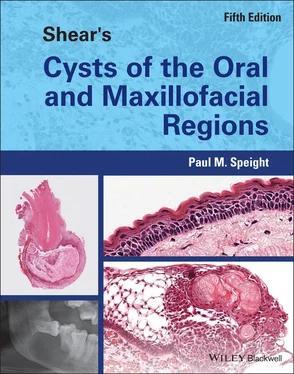Paul M. Speight - Shear's Cysts of the Oral and Maxillofacial Regions
Здесь есть возможность читать онлайн «Paul M. Speight - Shear's Cysts of the Oral and Maxillofacial Regions» — ознакомительный отрывок электронной книги совершенно бесплатно, а после прочтения отрывка купить полную версию. В некоторых случаях можно слушать аудио, скачать через торрент в формате fb2 и присутствует краткое содержание. Жанр: unrecognised, на английском языке. Описание произведения, (предисловие) а так же отзывы посетителей доступны на портале библиотеки ЛибКат.
- Название:Shear's Cysts of the Oral and Maxillofacial Regions
- Автор:
- Жанр:
- Год:неизвестен
- ISBN:нет данных
- Рейтинг книги:5 / 5. Голосов: 1
-
Избранное:Добавить в избранное
- Отзывы:
-
Ваша оценка:
- 100
- 1
- 2
- 3
- 4
- 5
Shear's Cysts of the Oral and Maxillofacial Regions: краткое содержание, описание и аннотация
Предлагаем к чтению аннотацию, описание, краткое содержание или предисловие (зависит от того, что написал сам автор книги «Shear's Cysts of the Oral and Maxillofacial Regions»). Если вы не нашли необходимую информацию о книге — напишите в комментариях, мы постараемся отыскать её.
Shear’s Cysts of the Oral and Maxillofacial Regions
Shear’s Cysts of the Oral and Maxillofacial Regions Fifth Edition
Shear's Cysts of the Oral and Maxillofacial Regions — читать онлайн ознакомительный отрывок
Ниже представлен текст книги, разбитый по страницам. Система сохранения места последней прочитанной страницы, позволяет с удобством читать онлайн бесплатно книгу «Shear's Cysts of the Oral and Maxillofacial Regions», без необходимости каждый раз заново искать на чём Вы остановились. Поставьте закладку, и сможете в любой момент перейти на страницу, на которой закончили чтение.
Интервал:
Закладка:
| References | Country | N | Radicular cyst a | Dentigerous cyst b | Odontogenic keratocyst | Other | Males (%) |
|---|---|---|---|---|---|---|---|
| Daley et al. (1994 ) | Canada | 6847 | 65.2 | 24.1 | 4.9 | 5.8 | NR |
| Mosqueda‐Taylor et al. (2002 ) | Mexico | 856 | 42.1 | 33.0 | 21.5 | 3.4 | 53.1 |
| Meningaud et al. (2006 ) | France | 695 | 58.2 | 22.3 | 19.1 | 0.5 | 65.0 |
| Jones et al. (2006 ) | UK | 7121 | 60.3 | 18.4 | 11.6 | 8.1 | 55.9 |
| Ochsenius et al. (2007 ) | Chile | 2944 | 61.9 | 18.5 | 14.3 | 5.3 | 52.8 |
| Grossmann et al. (2007 ) | Brazil | 2812 | 63.0 | 26.1 | 7.4 | 3.5 | 50.0 |
| Tortorici et al. (2008 ) | Italy (Sicily) | 1273 | 84.5 | 11.4 | 1.3 | 2.8 | 53.9 |
| Ali (2011 ) | Kuwait | 196 | 52.6 | 26.0 | 15.3 | 6.1 | 57.6 |
| Sharifian and Khalili (2011 ) | Iran | 1227 | 45.8 | 24.7 | 19.4 | 10.1 | 57.1 |
| Ramachandra et al. (2011 ) | India | 252 | 50.3 | 22.4 | 27.4 | NI | 61.2 |
| Manor et al. (2012 ) | Israel | 285 | 56.1 | 28.8 | 8.0 | 7.0 | 59.7 |
| Soluk Tekkesin et al. (2012b ) | Turkey | 5003 | 65.6 | 10.6 | 20.9 | 2.9 | 57.6 |
| Tamiolakis et al. (2019 ) | Greece | 5165 | 73.2 | 14.8 | 8.4 | 3.6 | 61.5 |
| Bhat et al. (2019 ) | India | 125 | 60.8 | 22.4 | 13.6 | 3.2 | 67.9 |
| Kammer et al. (2020 ) | Brazil | 406 | 53.4 | 14.0 | 15.0 | 17.5 | 56.7 |
| Aquilanti et al. (2021 ) | Italy | 2150 | 57.0 | 23.5 | 13.0 | 6.5 | 63.3 |
N, total number of odontogenic cysts – frequencies are proportions of odontogenic cysts only; NI, not included – proportions only given for the three main cyst types; NR, not reported.
aData for radicular cyst includes residual cysts.
bData for dentigerous cyst includes eruption cysts.
Among other cyst types, Jones and Franklin (2006a ) found that the most common were mucoceles (3.9%; n = 1720), while all other cysts were rare (less than 1.0%).
These data show that cysts are relatively common and that the most commonly encountered are the radicular cyst, dentigerous cyst, and mucoceles. They also suggest that when a periapical radiolucency is seen, about 50% will be a radicular cyst and 50% will be a periapical granuloma. Details of the frequency and incidence of each cyst type are illustrated and discussed in the following chapters.
2 General Considerations
CHAPTER MENU
Pathogenesis of Cysts
The Cyst–Tumour Interface
An Approach to the Diagnosis of Cysts of the Jaws Radiology of Cysts of the Jaws Histopathological Examination of Cysts Immunohistochemistry and Molecular Pathology
Cysts of the oral and maxillofacial regions are common and represent about 20% of all lesions encountered in an oral and maxillofacial pathology department (Jones and Franklin 2006a ,b ; discussed in Chapter 1). Clinicians are often therefore called upon to make an informed diagnosis and implement correct management. Of all the cysts discussed, those within the jaw bones are the most challenging to diagnose. Overall the most common jaw cyst is the radicular cyst, which presents as a periapical radiolucency and is probably the most common cause of a bony swelling in the tooth‐bearing areas of the jaws. The challenge is to accurately make a diagnosis and exclude other possible causes of a swelling or of a radiolucency. In most cases, a final diagnosis usually requires histological examination of the cyst, and it is the histopathologist who often takes responsibility for bringing together the clinical, radiological, and histological features and reporting the final diagnosis to the surgeon. Each cyst type has characteristic features and these are discussed and illustrated in each chapter of this book. In this chapter we consider general issues that help inform a careful and accurate approach to the diagnosis of cysts, and we summarise specific radiological and histological features that have diagnostic utility in the diagnosis of different cyst types.
Pathogenesis of Cysts
The formation of a cyst requires three elements and can be considered to develop in three phases: a phase of initiation, a phase of cyst formation and a phase of growth and enlargement ( Box 2.1). For the inflammatory odontogenic cysts, the processes of cyst formation and expansion are well understood and are considered in detail in Chapters 3and 4, but for the developmental cysts the mechanisms are not so clear and many theories have been suggested, including aberrant developmental processes, underlying genetic abnormalities, and neoplasia. These are discussed in detail for each cyst type in the following chapters. For most cysts, the lining is derived from epithelial remnants or inclusions that remain in the tissues after developmental processes are complete. Table 2.1shows the source of epithelium for each cyst type and summarises the developmental origin. To fully understand the pathogenesis of cysts, it is therefore essential to have an understanding of the embryology and development of the head and neck. With regard to the odontogenic cysts (and odontogenic tumours), a thorough knowledge of tooth development is also needed to understand the pathogenesis, since the complex interactions between epithelium and mesenchyme that underpin normal morphogenesis and tooth eruption provide good models for the processes that drive cyst formation and growth. In addition, the histology of many lesions may recapitulate the features of the developing tooth and knowledge of these features facilitates the ability to reach an accurate diagnosis. A detailed consideration of embryology and development is beyond the scope of this book, but factors relevant to each cyst type are summarised in each chapter. For up‐to‐date and expert knowledge relating to development, readers should consult expert texts or reviews (Wise et al. 2002 ; Nel et al. 2015 ; Nanci 2017 ; Seppala et al. 2017 ; Diniz et al. 2017 ; Hovorakova et al. 2018 ; Bastos et al. 2021 ).
Box 2.1Pathogenesis: The Phases of Cyst Formation
Three elements are needed:
A source of epithelium
A stimulus for epithelial proliferation
A mechanism of growth and bone resorption
The cyst develops in three phases:
Phase of initiation – a source of epithelium and stimulus for proliferation
Phase of cyst formation – a cyst cavity develops and becomes lined by epithelium
Phase of growth and enlargement – the cyst enlarges, and growth is accompanied by tissue remodelling and bone resorption
Table 2.1 Sources of the epithelial lining of cysts of the head and neck.
| Source of epithelial lining | Developmental origin | |
|---|---|---|
| Odontogenic cysts | ||
| Radicular cyst | Cell rests of Malassez | Remnants of the epithelial root sheath of Hertwig lie in the periodontal ligament ( Figure 3.6) |
| Dentigerous cyst Eruption cyst Inflammatory collateral cysts | Reduced enamel epithelium | Reduced enamel epithelium forms from the internal and external enamel epithelium and embraces the fully formed crown of an unerupted tooth. This gives rise to the dentigerous (and eruption) cyst ( Chapters 5and 6, Box 5.3, Figures 5.18 and 5.19). The reduced enamel epithelium also forms the junctional or sulcular epithelium during tooth eruption and this gives rise to inflammatory collateral cysts ( Chapter 4) |
| Odontogenic keratocyst Lateral periodontal cyst Botryoid odontogenic cyst Gingival cyst of infants Gingival cyst of adults Glandular odontogenic cyst Calcifying odontogenic cyst Orthokeratinised odontogenic cyst | Cell rests of the dental lamina (‘glands of Serres’) | After tooth formation is complete the dental lamina disintegrates, but residual islands are retained in the gingival mucosa and alveolar bone. Cell rests are particularly common in the posterior mandible, where they may also be found in the gubernacular cord or canal (discussed in detail in Chapters 7, 8, 9, and 12; see Figures 7.12, 8.3, 9.7, and 9.9) |
| Non‐odontogenic cysts | ||
| Nasopalatine duct cyst | Remnants of the nasopalatine duct | The nasopalatine duct is a fetal structure and involutes at about 10 weeks of intrauterine life. Residual epithelial remnants, however, may remain in the incisive canal after birth and in adults ( Chapter 13, Figure 13.1, Box 13.1) |
| Nasolabial cyst | Nasolacrimal duct | The nasolacrimal duct forms after 6 weeks of intrauterine life and drains tears from the lacrimal sac to the lower aspect of the lateral nasal wall. Residual epithelial remnants may persist at the inferior portion of the duct ( Chapter 14) |
| Mid‐palatal raphe cyst (Epstein pearls) | Epithelial inclusions | The palatal shelves fuse at about 7–8 weeks of intrauterine life. The epithelial coverings fuse and then break down into many small islands, many of which form small ‘microcysts’ (Figure 9.7). Most involute before birth, but up to 80% of newborns may have cysts up to 3 months of age ( Chapter 9). There is some evidence that inclusions may arise in the bone and give rise to an intraosseous ‘median palatal cyst’ (discussed in Chapter 13) |
| Surgical ciliated cyst | Remnants of respiratory epithelium | Fragments of sinus epithelium become implanted into a wound following surgery involving the maxillary sinus ( Chapter 16) |
| Cysts of the salivary and minor mucous glands | ||
| Mucous retention cysts | Ducts of minor mucous glands | The ducts of minor mucous glands become blocked and dilated, most often as a result of trauma (Figures 15.5, 15.6, and 15.10) |
| Salivary duct cyst Lymphoepithelial cysts | Intraparotid ducts | The pathogenesis is uncertain, but blockage of ducts associated with sialadenitis may cause cystic dilatation (Figure 15.12) |
| Intraoral lymphoepithelial cysts | Tonsillar crypt epithelium | The opening of intraoral tonsils may become blocked, causing cystic dilatation of the crypt. Some intraoral lymphoepithelial cysts may be retention cysts arising from a superficial duct of minor salivary glands |
| Developmental cysts of the head and neck | ||
| Intraoral dermoid and epidermoid cysts | Epithelial inclusions | Epithelial remnants are sequestered into the tissues during fusion of facial processes. Oral dermoid and epidermoid cysts are found in the anterior oral cavity at sites of fusion of the mandibular processes ( Box 18.1) |
| Intraoral cysts of foregut origin | Epithelial inclusions | Oral foregut cysts arise from epithelial remnants following fusion of the tuberculum impar (first branchial arch) and the posterior one‐third of the tongue (second to fourth arches) ( Box 18.2) |
| Branchial cleft cysts | Epithelial inclusions | Branchial cleft cysts arise from epithelial remnants that become entrapped or persist due to incomplete obliteration of the branchial clefts or pharyngeal pouches ( Box 18.3) |
| Thyroglossal duct cyst | Remnants of the thyroglossal duct | The thyroid gland develops at about 4 weeks of intrauterine life in the dorsum of the tongue. The developing gland descends downwards into the upper neck forming the thyroglossal duct, which then disintegrates. However, residual epithelial remnants are found in the midline of the upper neck and tongue in about 40% of people ( Box 18.4) |
In the majority of odontogenic cysts, the epithelial lining is derived from epithelial remnants of the dental lamina ( Table 2.1). Early in the development of the jaws, the surface epithelium thickens and grows downwards into the mesenchyme of the future dental arches to form the dental lamina. This extends around the arch as a band that maps the future sites of tooth bud formation for both primary and secondary dentitions. The teeth develop as a result of complex epithelial–mesenchymal interactions that result in epithelial thickenings or placodes, which then form the enamel organs that pass through the well‐described bud, cap, and bell stages during formation of the fully developed tooth (Nanci 2017 ). The dental lamina remains as a thin band that joins the surface oral epithelium to the enamel organ and only disintegrates at the late bell stage of tooth development. Disintegration of the dental lamina results in the formation of small epithelial islands that lie over unerupted teeth, but also remain in the tissues adjacent to the teeth after eruption. The disintegrating vdental lamina is illustrated in Figure 9.9. The epithelial cell rests of the dental lamina give rise to most of the odontogenic cysts ( Table 2.1) as well as to most odontogenic tumours. Dental lamina rests are particularly numerous at the posterior aspect of the dental arches and in the tissues overlying unerupted teeth and in the dental follicle. This accounts for the fact that the angle of the mandible is a common site for many cyst types, and that many cysts (and tumours) may arise in the dental follicle and embrace or surround an unerupted tooth and lie in a dentigerous relationship. This especially affects the mandibular third molars, since these are the most commonly impacted teeth (Brown et al. 1982 ).
Читать дальшеИнтервал:
Закладка:
Похожие книги на «Shear's Cysts of the Oral and Maxillofacial Regions»
Представляем Вашему вниманию похожие книги на «Shear's Cysts of the Oral and Maxillofacial Regions» списком для выбора. Мы отобрали схожую по названию и смыслу литературу в надежде предоставить читателям больше вариантов отыскать новые, интересные, ещё непрочитанные произведения.
Обсуждение, отзывы о книге «Shear's Cysts of the Oral and Maxillofacial Regions» и просто собственные мнения читателей. Оставьте ваши комментарии, напишите, что Вы думаете о произведении, его смысле или главных героях. Укажите что конкретно понравилось, а что нет, и почему Вы так считаете.












